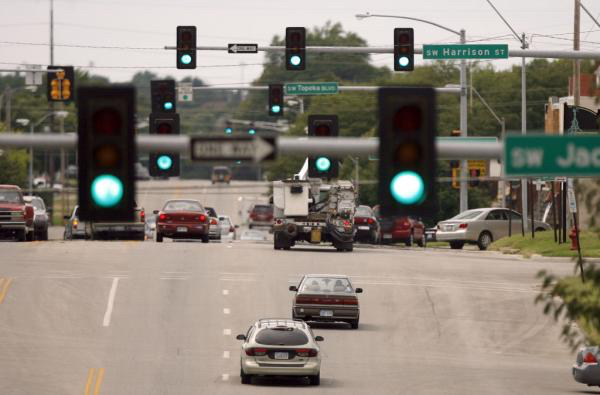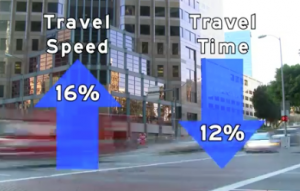Guest Post by Eric Peters

All this hubbub over how much gas cars burn and the government won’t even synchronize traffic lights.
How much gas does that waste?
An interesting study was done by a Stanford University researcher a few years back. Its author – Victor Miller – estimated that the average car needlessly stops – and then goes – about 15 times every day as a result of such things as unsynchronized traffic lights.
When multiplied by the approximate number of cars driven each day in urban/suburban environments – which is about 60 million cars – the study determined that the fuel wastage of avoidable decelerating, idling and re-accelerating accounts for about 1.2 billion gallons of wasted fuel annually.
That is an ocean of gas – and a lot more gas than “saved” by elaborate, expensive and annoying technology such as the engine stop/start systems being grafted to almost all new cars as a desperation measure to meet the government’s fuel economy fatwas.
Much more fuel could be saved simply by keeping the cars moving. And – as a bonus – we’d also save time, an invaluable (and never renewable) resource.
But it never gets done. The lights remain generally unsynchronized. Cars lurch forward, briefly. Then stop – and wait. It is like a Soviet-era bread line queue. Rinse, repeat – times 60 million, every day.
Not only is gas (and time) wasted, but also brake pads and tires – and tires are made of oil (mostly). I wasn’t able to find a study which quantified how much needless wear and tear on tires can be laid at the feet of avoidable stop-and-go driving, but a sound guess is probably “a lot,” since most of the wear and tear occurs from the initial friction of getting going – and the friction of stopping.
That adds up, too.
If you want to save fuel, the best thing you can do is keep moving – especially once already moving. It takes relatively little energy to maintain momentum; the energy bleed comes from getting three or four thousand pounds moving. And every time you apply the brakes to slow those three or four thousand pounds down, all that energy goes up in smoke, expressed as heat. If you want to feel your money being literally burned up, touch your brake discs after 10 minutes of stop-and-go-driving.
Much of it avoidable.
But no one in the government seems to care. They certainly aren’t acting – doing anything about it.
Why? You’d think – if fuel economy really was such a Big Priority, as they say it is – the EPA would be sending hither proverbial swarms of officers to make sure that every traffic light in the country was properly synced with the others in its vicinity.
But that is too much effort, apparently. Even though it would hardly cost the government anything.
Probably because it doesn’t cost us anything. Would actually reduce costs for us. Unlike for instance the electric cars being force-fed to us. Which cost both money and time, in the form of wasted time while waiting for the things to recover a charge so that we can resume driving.
Electric cars being the ultimate form of stop and go driving.
The government’s latest “fuel saving” stratagem is to make high-octane premium gas mandatory, so that the car industry can make high-compression engines standard equipment. High-compression engines are more “efficient.” But premium unleaded is also more expensive – about 40 cents more per gallon than regular.
Behold the genius of government.
It is the same genius which – apparently – does not grok that fattening up cars increases their appetite.
We can debate all night long about whether the government has any legitimate business telling the car companies – that is to say, telling us – that we have to buy “safe” cars (“safe” defined by the government as complying with a multitude of barrier-impact tests) but there is no debating that to make them “safe” means making them heavy and heavy cars burn more gas than lighter cars.
This is the reason why today’s cars often burn more gas than the cars of 40 years ago, despite all the technical advances of the past 40 years.
The most “efficient” 2018 model family sedans – with small four cylinder engines – approach 40 MPG on the highway. They would be capable of exceeding 50 MPG – if it weren’t for the fact that they are so fat. And they are fat because of all the steel which has been added to make them “safe” as the government defines that.
Perhaps the government isn’t so smart, after all.
If it were – and if it really did care about efficiency as opposed to controlling us – the lights would be synchronized before the end of next week. The fact that they aren’t – and likely never will be – tells us a lot about the government’s true priorities.





I suspect it is not deliberate, it is just that every government worker, with little exception, gets in to a government job for the same reason – they can sit on their fat ass, do nothing, tell other people at the point of a gun what to do, and then retire with a gold plated pension, funded by those that actually produce something of value.
When that is the profile of that average government drone, anything as logical as the above simple change will allude them for an entire career – career being only about 20 years in government, as they retire early.
I have no use for just about anyone that works in, or is associated with government in any way. And to expect, or even have the slightest hope of anything efficient, noteworthy, or of any useful consequence coming out from the swamp of useless drones called modern government, is a fantasy at best. /rant over
There are exactly 17 traffic lights on my daily commute (I counted them). Most of them are on a major thoroughfare into the city and connect to the smaller city streets in squalorville. Speed limit through this area is 40mph. Often it’s packed of cars and moved under the speed limit – but it moves, unlike the freeway which does not. When it’s wide open I’ve noticed the lights are timed, but not at 40mph. They are timed perfectly if I go 55mph. That’s fine, get me out of the city faster. Then I hit the suburban enclaves and the lights are timed to some different metric. At least there they are much further apart so it’s not as big of a deal.
Traffic light timing, or lack of it, is usually controlled by the city the lights are located in.
As an engineer who works on transportation projects a few reasons exist for traffic signals not being synchronized in addition to lazy government workers.
1) To get signals into sync they must be connected. That means stringing wires between them above or underground. This is not an inexpensive proposition.
2) Even when signals are connected, the controls (the electrical apparatus in the boxes on the corners with the signals) must be relatively new. Older controllers can’t be synced with other signals. Installing new controllers is not cheap.
3) Businesses along a street do not want traffic speeding by. They often prefer drivers suffer stop and go traffic to increase their disability and business on these thoroughfares.
4) Since signals are seldom evenly spaced for long distances, syncing them in one direction will likely screw up the smooth flow of traffic in the other direction. At this point someone will say, just change the sync in the morning and evening rush-hour. Those people should read #2 above again.
5) Some cities want to make it miserable to drive so people think taking public transit makes sense. However, #5 doesn’t occur that much. Even in Portland, where public transit is like a god, syncing signals is still a priority.
Bottom line is that it ain’t cheap and it ain’t easy to synchronize traffic signals. Sometimes it isn’t done because of lazy public employees; but usually it isn’t done because it costs money. And politicians would rather spend money on something that involves ribbon cutting.